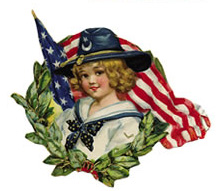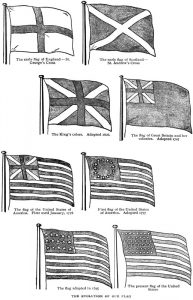The Stars and Stripes
 By Henry Russell Wray
By Henry Russell Wray
While every lad and lassie in the land knows and has read all about the famous old Liberty Bell, too little is known of the origin and growth of America’s dearest emblem—her flag. William Penn’s city—Philadelphia—is gemmed with many historical landmarks, but none should be more dear to us than that little old building still standing on Arch street, over whose doorway is the number—239. For in a small back room in this primitive dwelling, during the uncertain struggle for independence by the American colonies, was designed and made the first American flag, known as the “Stars and Stripes,” now respected and honored in every quarter of the world, and loved and patriotically worshiped at home.
The early history of our great flag is very interesting.
It is a matter of record that during the early days of the Revolution the colonists made use of flags of various devices.
It is nowadays generally accepted as a fact that the final idea of the Stars and Stripes as a national flag was borrowed from or suggested by the coat of arms of General George Washington’s family.
The first definite action taken by the colonies toward creating a flag, was a resolution passed by Congress in 1775, appointing a committee of three gentlemen—Benjamin Franklin and Messrs. Harrison and Lynch—to consider and devise a national flag. The result of the work of this committee was the adoption of the “King’s Colors” as a union (or corner square), combined with thirteen stripes, alternate red and white, showing “that although the colonies united for defense against England’s tyranny, they still acknowledged her sovereignty.”
The first public acceptance, recognition, and salute of this flag occurred January 2, 1776, at Washington’s headquarters, Cambridge, Massachusetts. The name given to this flag was “The Flag of the Union,” and sometimes it was called the “Cambridge Flag.” The design of this flag was a combination of the crosses of St. George and St. Andrew in a blue field in the upper left-hand corner, bordered by thirteen stripes for the thirteen colonies.
But in the spring of 1777 Congress appointed another committee “authorized to design a suitable flag for the nation.”
This committee apparently consisted of General George Washington and Robert Morris. They called upon Mrs. Elizabeth (Betsy) Ross, of Philadelphia, and from a pencil-drawing by General Washington engaged her to make a flag.
This flag, the first of a number she made, was cut out and completed in the back parlor of her little Arch street home.
It was the first legally established emblem, and was adopted by Congress June 14, 1777, under the act which provided for stripes alternately red and white, with a union of thirteen white stars in a field of blue. This act read as follows: “Resolved, That the flag of the United States be thirteen stripes, alternate red and white: that the union be thirteen stars, white in a blue field, representing a new constellation.”
